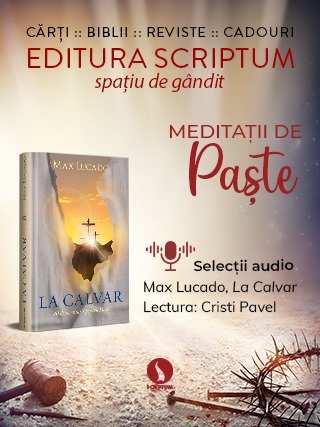Studii
-
de Petru Loga
-
de Lori Balogh
-
de Adrian Fodor
-
de Ștefan Zambo
- C.S. Lewis (1)
- Carmen Iene (6)
- Roy Gane (1)
- PREOT DAVID... (8)
- Mogovan Neemia (1)
- Costel Oglice (6)
- AnonimP (21)
- Daniel Branzai (16)
- Beniamin... (1)
- Joe Crews (1)
- Alexei Tentiuc (4)
- Ciprian... (14)
- Puchea Dorel (1)
- Samuel BSV &... (13)
- Sergiu Filat (8)
- Lori Balogh (165)
- Ioan Pribac (1)
- Walter Martin (1)
- Oxana Tentiuc (3)
- Remus Ruptasu (1)
- Carol szekely (1)
- Preot Teodor (2)
- Oltean Nicolae (1)
- John Coffey (3)
- Depresie (6)
- Istoria... (1)
- Suferință (4)
- Moarte (1)
- Teamă (2)
- Paște (8)
- Doctrină (38)
- Bani (9)
- Ispită (7)
- Misiune (3)
- Atributele Lui... (15)
- Botez (3)
- Contemplare (1)
- Îndoială (1)
- Păcatul (17)
- Duhul Sfânt (9)
- Nașterea... (8)
- Viața... (2)
- Diverse (1376)
- Căsătorie (18)
- Boală (1)
- Controverse (20)
- Revenirea... (7)
- Apocalipsa (36)
- Daniel 7:1-8:14
- 1 Ioan 3:9
- Matei 24:36-51
- 1 Corinteni 9:24-27
- Hagai 1:4-15
- Faptele apostolilor 13:22
- Ieremia 14:11-16
- Efeseni 2:8-9
- 2 Petru 1:1-3:18
- 1 Corinteni 3
- Ioan 14:1
- 1 Corinteni 1:1-16:24
- Ieremia 29:11-13
- Isaia 61:1-4
- Iov 2:1-2
- Matei 1:1-5
- 1 Corinteni 12:27
- Efeseni 3:1-12
- Ioan 1:4-5
- 1 Ioan 2:15-17
- Faptele apostolilor 2:17
- Deuteronomul 7:13
- Evrei 11
- Matei 6:16-16:18
Alte resurse text
- Acorduri: 4515
- Biografii: 75
- Cântece: 27129
- Cărți: 233
- Cugetări: 1964
- Devoționale: 8980
- Dezbateri: 75
- Editoriale: 857
- Eseuri: 5643
- Jocuri: 46
- Lecția zilnică: 124
- Mărturii: 575
- Maxime: 17302
- Partituri: 11458
- Poezii: 86775
- Powerpoint: 869
- Predici: 3410
- Programe creștine: 55
- Reviste: 127
- Scenete: 53
- Schițe: 1293
- Studii: 2159
- Versete: 103
Iosua 1:9 Nu ţi-am dat Eu oare porunca aceasta: ‘Întăreşte-te şi îmbărbătează-te’? Nu te înspăimânta şi nu te îngrozi, căci Domnul Dumnezeul tău este cu tine în tot ce vei face.”



